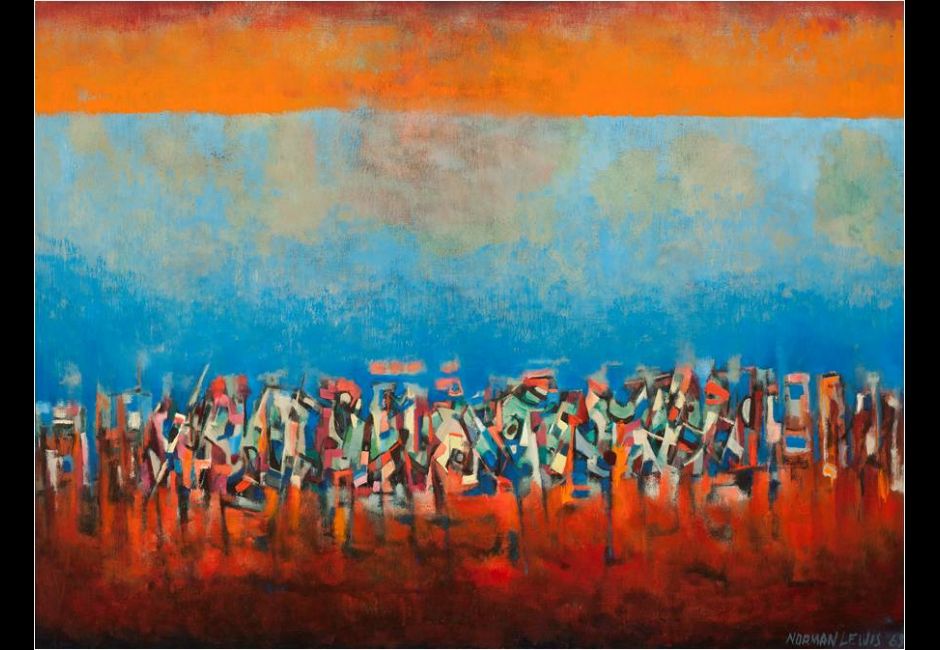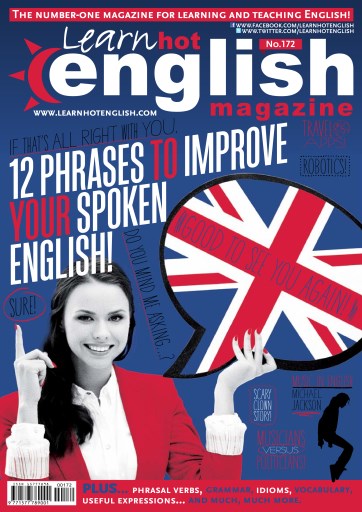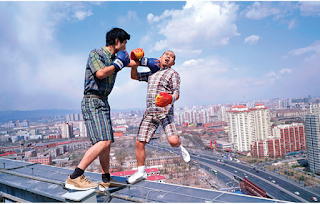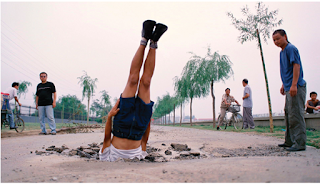1. PHOTOGRAPH
DESCRIPTION, by Isabel Natalia Revenga
OBJECTIVES:
-
To
practice oral skills (listening and speaking).
-
To
practice and revise vocabulary already seen in previous units.
-
To
foster teamwork so weaker students can be helped by stronger ones.
-
To introduce
participle clauses when making descriptions and compare them with relative
clauses.
GROUPING:
-
The
class consists of 17 students organised in 5 groups of 3 (1 high-level student,
1 medium and 1 low-level) plus 1 group of 2.
TIMING:
-
30-35
minutes in total.
-
10
minutes in small groups to prepare questions and discuss the topic.
-
20-
25 minutes to exchange questions and answers. Discuss about possible topics and
subtopics that may arouse.
DESCRIPTION OF THE ACTIVITY:
Students
had ten minutes to prepare questions related to the pictures in small groups,
not only focusing on what they were seeing but on people’s feelings,
suppositions and other aspects that could be inferred by different objects,
background and people’s faces.
Then,
each group asked the questions to the other students. In this way, they
described the pictures and thought more on suppositions than in physical and
obvious characteristics and we spoke about related aspects. This part lasted
for 20-25 minutes.
The
students really got into the activity making reference to aspects and details
that could hardly be noticed, leading to a conversation beyond physical
characteristics shown on the pictures.
We have also worked on this activity splitting the
whole class into two groups, each one with another colleague. In our high
school for some levels at the English Department, the teachers are used to
sharing and dividing the whole group into smaller ones - having agreed what and
how to do, what the students´needs are at that moment… beforehand-at least once
a week, depending on the students’ needs and the schedule (these are the so
called “desdobles”). Thus, we offer them the chance to improve their weaker
performances in small groups with their own classmates, and, to a large extend,
their self-confidence. As explained at the beginning of this activity in
“grouping”, in this class of 17 students, one of the teachers would take a
group of 8 and the other 9, keeping in mind their different levels: thus, each
teacher should organise her groups in 4 or 5 high-level, medium and/or low
level learners so that they can help each other in a cooperative way.
Once more, not only the two teachers, but also the
students are pleased with the results on working on this type of activity in
smaller groups.
CONCLUSION:
This activity was really useful to avoid the normal
type of picture description in which a single student describes a picture
following a pattern and fixed expressions.
In this way, students have had the opportunity of
working in groups helping each other and they have exchanged good ideas that
not all of them had thought about.
To some extent, students have developed the skill of
analyzing an image looking at it in real depth, not only saying what they have
seen at first sight, but inferring information, making suppositions and
predictions.
Apart from boosting the oral skills of students, this
activity has also helped them to learn that not everything we see at first
sight can be taken for granted; we need to analyse and look deeply into images,
adverts, slogans, etc. to see what they really want to transmit.
2.Working with art images and titles,by Francisco Javier López.
Grade level: B1 students
Time: about
30 minutes
Context: The
class is made up by about 25 students who are from all walks of life and belong
to different age groups, although there are a high percentage of teenagers.
Materials
I have chosen the following
pictures:
1.
A
Still Life, by the Dutch artist
Floris van Dyck, because it clearly represents what it is understood by ‘still’
and it shows commonplace objects that are both natural (there are grapes,
apple, nuts, olives, etc.) and manmade (a knife, a glass, a plate,…).

2.
The
Self Portrait Yo Picasso, because he
painted himself as he was feeling at that time, a proud and confident artist
who was at the rise of his career.
3.
Always Together, by the surreal painter Vladimir Kush,
as it is a very imaginative piece of art and open to interpretation.
4.
Genesis, by the professional photographer Sebastião Salgado (the picture selected shows a line of penguins jumping
off an iceberg in the South Georgia and South Sandwich Islands), as his black
and white artwork tries to take us back to the origins of the our planet, while
showing us images of raw nature.
5.
Procession, by Norman Lewis, which shows a
colorful representation of abstract work.

Activity
I gave students the titles of the
above mentioned works of art. First, in pairs, they had to write down a
description of the type of work of art they expected to see. When I saw that
most people had finished, I asked them to sit in groups of four and discuss
with the other pair the different descriptions provided.
After some minutes, I showed them the
real pictures and we had a general discussion about if the title fits the
artwork and what they thought of the images.
Follow up
Each student is asked to select two
pieces of artwork from the activity and has to write a paragraph stating:
1.
Their
attitude to the piece of art and understanding of it before knowing its title.
2.
How
their ideas changed after knowing the title of the picture.
3.MUSIC
Activities proposed by Esther Arranz:
As a Music teacher, after
Easter holidays and especially during May my students are involved in the
rehearsals for the annual concert. It took place yesterday. Taking that into
account, and considering that my main goal in class is to teach music I am sorry
and concern because at this moment I cannot offer an activity to share with the
other teachers. However, I would like to comment on the ideas, tips or
resources in general that I highlighted during the course because I consider I
can take advantage of them for teaching the more theoretical contents in my
Music class.
·
Prompts: I suppose every
experienced teacher gives cues in order to help students to elicit ideas,
answers. My reflection on this point is to use prompts in a more explicit and
written or visual way, in state of just providing students with a few oral or
improvised tips.
· Visual literacy: My students spend most of the class time with performing
activities, playing instruments, singing or dancing. However, I will take this
advice into account when we address more theoretical contents, such as the
History of Music. I use to arouse their curiosity with music, just sound; I
will try with images or, probably even better, with music and images. It is
very easy to find Classical music in films and commercials.
·
Videos: “not more than 2
minutes long”. I must confess that I was surprised with this statement.
Definitely, I have to divide the selected videos for the bilingual groups into
smaller sections.
·
Kidspot: the activity you
chose “Same name. Each of the items on the left shares its name with one
shown on the right. Match the names” made me consider the possibility to
work cooperatively with the English teacher looking for words or pairs of
homonyms where one of the meanings or one of the homonym is a musical term:
horn, pipe, organ, brass, triangle, movement, scale, tonic, dominant, tie,
hold, flag, bar, key, meter, peg, neck, bridge, (finger)board
·
Sounds of American English - The University of Iowa
·
Hot English Magazine: I have been surfing into its web page and I found a free article with
its corresponding mp3 about the music industry in the UK (http://blog.learnhotenglish.com/learn-8-useful-business-english-expressions-and-find-out-about-the-importance-of-the-music-industry/).
This topic matches the contents in 4º ESO. There are many others that seem
interesting (e.g. Culture – world dances, Music – controversial stars)
but I could not read them yet.

·
Let students give short presentations in groups: I learned in your course that it is not
necessary to have individual presentations –that is, more than 20, even 30
presentations per group-. I have highlighted this tip because it was the
activity I have planned for today. The previous week the students were asked to
prepare at home different topics from their book. The idea was that they make
groups of 6 students and each one gives their presentation to the other five.
However, today class was the first class after the concert. They were excited,
they wanted to see the recording and to talk about the other classes’
performances, we watched the recording and just at the final part of the class
time we tried to organise the groups. I knew it was not the right day, they
felt like in a party. First idea as feedback, it is important to choose the
right day and evaluate the mood of your students. The positive part is that now
they know what they are going to do next day and they will be able to focus on
the task as soon as they are divided in groups.









No hay comentarios:
Publicar un comentario